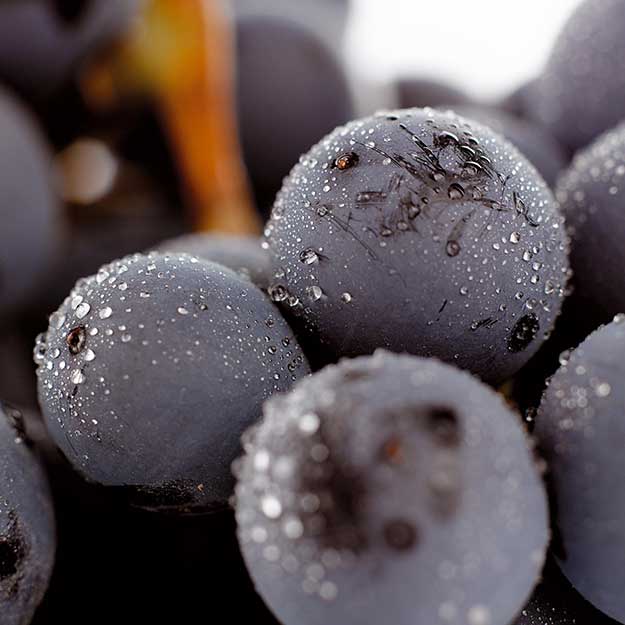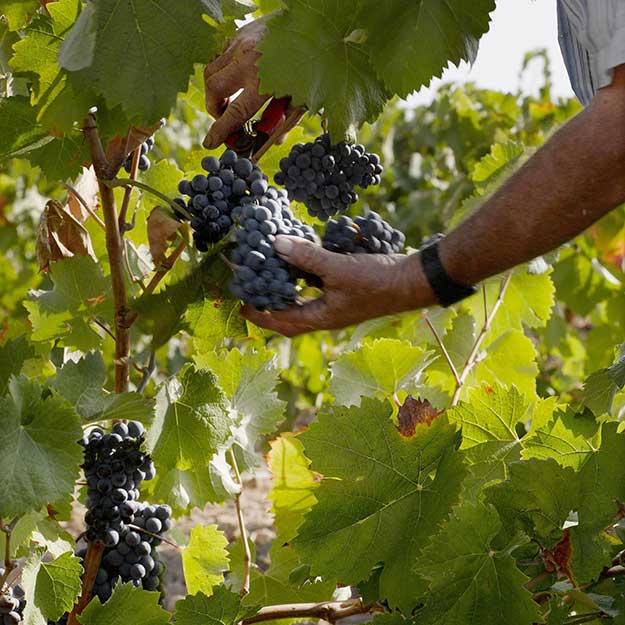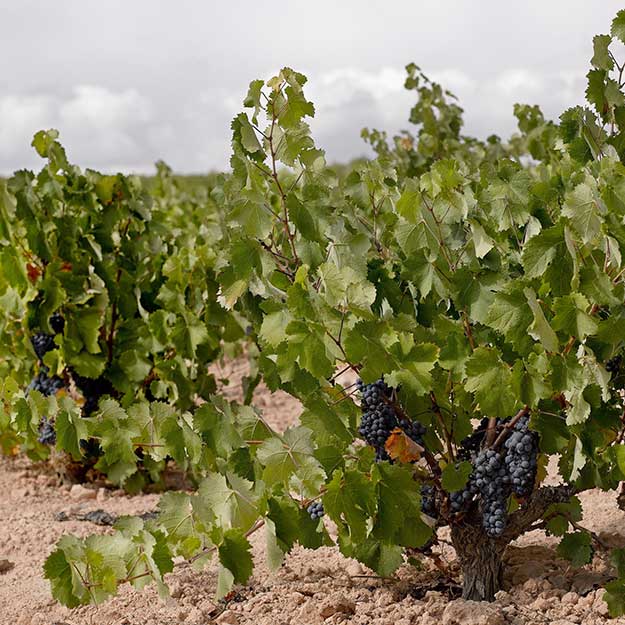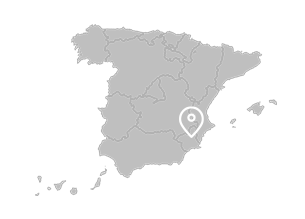.png.transform/rendition-xs/image_image%20(1).png)
Monastrell in Its Element
No doubt that things have come a long way, not in the last place owing to a rising number of highly motivated and internationally schooled enologists. From the turn of the century onwards, Monastrell, historically known as a high volume, strong-colored variety primarily sold in bulk, has gained a keen interest within the sector and its overall reasonably priced wines have clearly conquered a niche thanks to their unique terroir and personality.
Text: Almudena Martin Rueda /@ICEX

Monastrell, also known as Murviedro, is thought to have originated in medieval Morvedre (today’s Sagunto, Valencia), but is known as well in France as Mourvedre and in the US and Australia as Mataró. The name Monastrell suggests that monks may have cultivated and spread the variety. Archaeological evidence puts a semi-cultivated vine in Murcia some 5,000 years ago, actual cultivation in the Iberian period (5th-6th centuries BC), and larger scale development by the Romans.Thankfully it has survived overtime and today has been restored, as we will see, to its full splendor.
Thus there is an undeniable local pride in Murcia as to “their” Monastrell, which over the centuries has adapted very well to the harsh climate conditions. Temperatures, in particular for the high plains of Jumilla and Yecla (Bullas is a bit milder), may vary from 45ºC in summer to -10ºC in winter and day and night temperatures may oscillate by up to 20ºC, especially at greater altitudes. Moreover, rainfall rarely exceeds 350 mm a year, but “only if lucky” according to the DO Jumilla.
In general, the Monastrell producing vineyards are not watered and vines are grown in the traditional vase shape, except for a few areas (at loer altitudes in Yecla and Bullas) with espaliered, irrigated vines. The well-aired stocks are fairly disease-resistant and their late budding shoots prevent against spring frost damage. The medium-size, compact bunches bear small berries, which ripen late and at harvest show a high sugar content, allowing for a volume of 13 to 14.5º.
The vines have also adapted very well to different, yet always poor soils. The sandy soils of Jumilla kept the ubiquitous phylloxera from spreading widely and as a result, some ungrafted Monastrell vines have survived. Luckily so, because as José María Vicente, owner-enologist at Casa Castillo (Jumilla) explains, there is ample agreement that such vines best express the variety. One of his wines, Pie Franco, from ungrafted vines planted by his grandfather is a case in point, but not the only one.
With some 30,000 hectares (74,132 acres), Jumilla is the largest of the three Monastrell based DOs. The area itself together with the adjacent province of Albacete (similar in characteristics and part of the DO) produces 24 million liters of DO wine. 45% of their bottled wine is exported. While Monastrell is predominant in all three Designations of Origin, no stipulation is fiven as to a required percentage. However, to rightfully carry the specific DO Jumilla Monastrell label, wines have to contain 85% of this variety.
A grape much honored

So let us first have a look at how some Jumilla bodegas honor their favorite grape. At the foot of El Carche, the highest peak in the production area, we find the winery Casa de la Ermita, which has become one of the best known and highly rated among the Jumilla wineries, exporting to more than 40 countries. They consider the Monastrell the region’s pre-eminent grape to confer the DO’s distinctive character as a warm, concentrated, Mediterranean wine without sharpness.
Also at the cooperative Bodegas San Isidro (BSI), the focus is increasingly on quality wines and on the Monastrell as the distinguishing feature to differentiate their wines from other production areas. BSI emphasizes the distinct advantage of the grapes being consistently allowed to fully ripen throughout the very long summers in Murcia.
The dry climate and the variety’s resistance to the most common grape diseases allow growers here to avoid aggressive vineyard treatments. Thus production at wineries such as Bodegas Bleda, of which 80% is exported, can almost be described as organic. In fact, in 2012 they launched Flor de Escarche an officially certified 100% Monastrell organic wine.
Bodegas Luzón has even created a certified organic division. Besides they have, built a totally new winery where they produce their flagship wines. Together with the Enological Research Center in Jumilla (the oldest in Spain), and not unlike others in the area, they experiment with new varieties to complement the Monastrell and have for example found that Syrah is “an ideal partner,” adding a welcome flowery touch.
And last but certainly not least there is the Gil family with its wineries Bodegas Juan Gil and the more specialized Bodegas El Nido. They teamed up with international merchants and advisors and have probably been the most crucial in taking Jumilla to a star position in wine guides world-wide, thanks to their exciting and well-balanced wines.
From bulk to Top 100

At the other end of El Carche lies Yecla, particularly well known for its buoyant furniture sector, with wine as the -certainly not to be underestimated- second source of income. DO Yecla covers some 6,500 hectares (16.000 acres), 85% of which produce Monastrell, mostly on the high, dry-farmed lands, whereas the lower largely irrigated areas also grow other red and some white varieties.
That wine has been and continues to be important for Yecla also socially may be underscored by the fact that as early as 1973 the local cooperative La Purísima made the Guinness Book of Records for being the world’s largest wine producer (60 million liters). Today production, while still substantial (12 million liters), has been lowered to produce quality wines with the help of state-of-the-art technology and careful growing and winemaking practices. This has also allowed them to produce their top-quality Trapío wine from ungrafted 50-year old stocks. But not only that: their 100% Monastrell Valcorso Ecológico, was the sole Spanish organic wine to make the Top 100 at London International Wine & Spirits 2008.
Yet the true pioneers particularly in recognizing the great potential of the Monastrell to yield wines of exceptional quality is the Castaño family. Today Bodegas Castaño exports some 3.5 million bottles of excellent widely acclaimed Monastrell wines (a.o. Hécula, Casa Cisca, Castaño Organic, Castaño Rosé) Confessedly their success is due to strict and environment-friendly vineyard, grape and harvest management, together with careful aging “just long enough to bring out the appropriate complexity, intense aromas, velvety texture and full body.”
Mediterranean influence
Some 80 km. Southwest, we find Bullas where vineyards have two propitiating allies, namely the Andalusian mountain range forming high plains and cool valleys as well as humidifying east winds from the Mediterranean. DO Bullas is the smallest of the three and covers some 5,000 hectares (12,355 acres). Known in the 18th century as the largest winery in Murcia, here vineyards were almost completely wiped out by phylloxera. But the 20th century saw a revival and in 1994 Bullas was awarded Designation of Origin status.
Controlling 80% of the total Bullas vineyards and 95% of all DO exports is Bodegas del Rosario, a cooperative that has recently upgraded its operations. Having been one of the largest bulk producers, it is now also producing quality wines, some of which, like Las Reñas have won several international awards. Also here excellence derives from careful tending of the vines, new winemaking technology and expert professional advice from foreign and local experts. No surprise that they were behind the wine called ‘3000 Años’, a blend from over 50-year old Monastrell stocks and Syrah which received 93 points on the Robert Parker scale.
It was in 1998 that the six siblings of the Fernández family, motivated by an eye-opening speech from a DOCa Priorat enologist, decided to enhance the value of their vineyards in the beautiful Aceniche valley, by producing their own wines instead of taking the grapes to the local cooperative. Alongside their old Monastrell stocks, they planted espaliered Syrah, Cabernet Sauvignon and Merlot with the idea of endowing their wines with some specific touches. Today, thanks to careful harvest timing for each variety and the storage of bottles for up to five years to achieve a perfect blend of varieties and wood, their winery Bodega Balcona produces excellent wines under the three labels, Partal, 37 Barricas and Casa de la Cruz.
No doubt that Murcia thanks to its main variety Monastrell has become a wine-growing area where tradition and favorable natural circumstances have met with passion, courage and expertise so as to ensure wine-lovers home and abroad some exciting new experiences.


